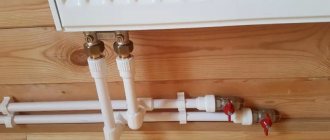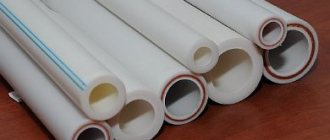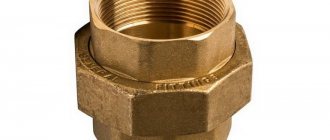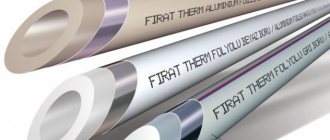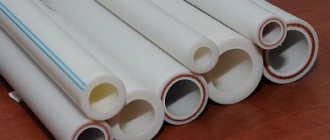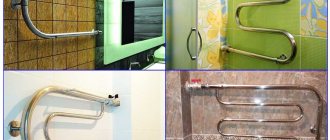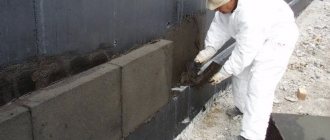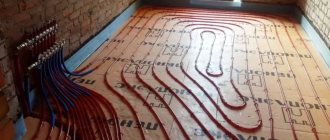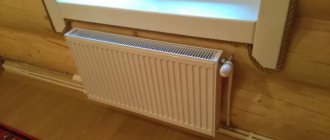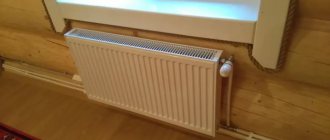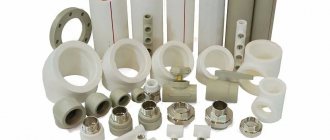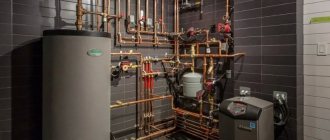When arranging autonomous heating and hot water supply, it is extremely important to correctly select materials for the pipeline. Pipes must not only comply with operating conditions, but also be conveniently installed using all available methods. Let's look at what a fiberglass-reinforced polypropylene pipe is, what its pros, cons and scope of application are, what types there are, how it differs from its aluminum-reinforced counterpart, and what options for its installation exist.
Polypropylene reinforced pipes are used for heating systems Source antagroup.ru
general characteristics
Pipes reinforced with glass fiber create serious competition with analogues reinforced with aluminum foil. Such risers are characterized by a three-layer structure: polypropylene - fiberglass - polypropylene. The reinforcing layer is also made from propylene, reinforced with fiberglass - glass fibers. In terms of its technical parameters, the adhesion of plastic to glass fibers can be compared to the strength of a monolith.
Glass fiber reinforced pipes are characterized by the following marking: PPR-FB-PPR.
If we compare risers with aluminum and fiberglass frames, the first option has one significant advantage: the products have greater rigidity. This means that when installing systems 1.5 meters long or more, such risers must be secured to the walls with special fasteners. Otherwise, sagging, deformation, and failure of the structure are possible.
Regarding diameters, it should be noted that products can be produced with diameters from 20 mm to 110 mm. It is these risers that can be found on sale more often than others. Although, for example, elements with a diameter of 17 mm or less are used to install heated floors.
Products of small diameters are secured with plastic clips, and large ones with clamps.
Application area
Even knowing well all the positive qualities of polypropylene pipes, their choice is always made individually, taking into account all the nuances of a particular object.
When the coolant temperature changes, the properties of polypropylene may also change. For each type of pipe, there are limiting parameters that are marked on the outer surface.
Polypropylene products that can withstand heating of the coolant up to 95 degrees are ideal for almost all modern heating systems.
This heating limit includes a certain margin; if a short-term heating to 110 degrees occurs, the system will maintain its integrity and its characteristics will remain unchanged.
The softening of the polymer begins at temperatures above 140 degrees, and its melting is observed after 175 degrees.
Polypropylene products are not installed in centralized communications if severe frosts are observed in the areas where they are located. To maintain heat, you have to heat the coolant above the boiling point.
If the heating system operates in autonomous mode and has a sensor for monitoring the temperature of the heating medium, polypropylene products may be the best choice.
They are great for creating “warm floors” or regular room heating.
Polypropylene products
The technical characteristics of glass fiber reinforced polypropylene pipes depend on the polymer used for their manufacture. All products are marked, which makes it possible to immediately determine the areas of use of tubular parts.
Let's find out what the markings on the pipes mean. So, PPR is an English name, and PPR is a Russian name meaning that this is a Polypropylene pipe made from Random copolymer.
Such fiberglass-reinforced polypropylene pipes are used for heating, water supply systems, ventilation systems, and industrial pipelines.
When arranging utility networks, fiberglass-reinforced PPR pipes are increasingly being used. There is nothing strange in this, since they are reliable, quite lightweight, and there are significantly fewer problems with their installation.
Another important factor is cost. For example, the price of PPR pipes reinforced with glass fiber for heating is lower than their metal counterparts, which helps save the family budget. These, as well as other characteristics possessed by fiberglass-reinforced polypropylene pipes, contributed to its popularization and use in various spheres of the national economy.
With this article read: Main characteristics and scope of application of polypropylene pipes, diameter and what influences its choice. Classification by pressure and composition of raw materials. Polar questions and answers to them.
About installation errors
Let's think about why a metal-plastic pipe for water supply leaks. The reason lies solely and exclusively in gross installation errors.
How to
A compression fitting for metal-plastic is a herringbone fitting with one or two rubber O-rings seated in grooves. It is these rubber rings that must ensure the sealing of the connection. The shape of the fitting is intended only to ensure reliable fixation of the pipe crimped with a split ring.
Compression fitting device
Rubber O-rings provide sealing
Here are step-by-step instructions for installing the connection yourself:
| Image | Description of the work stage |
| Cut the pipe to size using a pipe cutter. A specialized tool for metal-plastic makes the cut perfectly even and strictly perpendicular to the longitudinal axis of the pipe. |
| Calibrate the end of the pipe using a hand calibrator. Small diameter pipes are usually supplied in coils, and after unwinding they retain an oval cross-section. The calibration makes it perfectly round. |
| Remove the internal chamfer at the end of the pipe. The chamfer will allow it to fit onto the fitting without moving the O-ring on its fitting. Calibrators for metal-plastic materials are often equipped with chamfering knives. |
| Apply a little neutral lubricant (silicone, liquid soap, etc.) to the fitting nipple. Do not use petroleum-based fuels and lubricants as a lubricant: the O-rings may crack over time. |
| Using a forward movement, slide the pipe with the union nut and split ring onto the fitting fitting and tighten the nut with moderate force. In this case, the fitting body must be held with a second key, which will prevent it from turning. |
How they do it
Now let’s remember how newcomers to the field of installing these pipes assemble heating and water supply from metal-plastic.
- For cutting, a hacksaw is usually used. The cut is only very approximately perpendicular to the axis of the pipe;
- No one removes the chamfer at the end. Moreover, even burrs from cutting are not always removed from the inner surface of the pipe;
- Calibration? No, we haven't heard. There is definitely no calibrator in the arsenal of a novice master. The oval pipe is pulled onto the fitting with force and tightened until it stops with a nut with a split ring.
The result fully corresponds to the efforts expended:
- An oval pipe with an oblique cut and an uncleaned chamfer pulled over the fitting pulls the O-rings out of the grooves and moves them towards the fitting body. In this case, the sealing rings often break (the edge of the pipe, as we remember, is uneven and has burrs);
- When tightening the union nut, the split ring compresses the pipe onto the fitting, ensuring sealing of the connection due to deformation of its inner shell;
- When heated to 70-80 degrees or more, softened polyethylene is squeezed out of the gap between the fitting and the core;
Polyethylene melts at +120 degrees, but it begins to soften already at 80 °C
- With subsequent cooling and the accompanying compression of all parts involved in the connection, the fitting leaks.
Sometimes, after two or three tightenings of the union nut, the connection can be sealed by crimping the fitting with a soft aluminum core. In this case, the polyethylene is completely squeezed out from under the core, leaving it defenseless against electrochemical corrosion. More often than not, small irregularities on the surface of the core and fitting interfere with sealing, and the connection continues to leak.
Irregularities and scratches on the fitting may interfere with sealing
What types of polymer pipes are there?
Currently, 2 types of polymer products are known:
- single-layer;
- multilayer.
What characteristics do each type of product have?
Single layer
There are 4 modifications of polypropylene risers of one-piece construction, used for heating or water supply.
1st type: PPN pipes.
Homopolypropylene is used for their production. They are used in engineering pipeline structures for supplying cold water, arranging ventilation, and industrial pipelines.
2nd type: RRV pipes.
The basis for production is polypropylene block copolymer. The products are intended for installation of underfloor heating and cold water supply networks.
3rd type: PPR pipes.
The material for the production of parts is random polypropylene copolymer. The main property of the substance: promoting uniform distribution of loads on the internal walls of pipelines.
Hot and cold water supply, underfloor heating systems, water radiator heating - this is a list of applications for risers of this type.
4th type: PPs pipes.
The main characteristics of the products: polypropylene with increased heat resistance is used for production.
The parts of such a line are able to withstand temperatures of transported media up to +95⁰С. If necessary, it is possible to transport media with temperatures up to +110⁰C for a short period of time.
The first three analogues are designed to operate at temperatures around +70⁰С. In short-term mode, operation is allowed at slightly higher temperatures.
Products of the 3rd type are covered with a special shell, which can completely eliminate the negative effects of ultraviolet radiation.
Important! You should not often use the system operation in the maximum permissible parameters mode.
About multilayer analogues
Polypropylene (PP) pipes consisting of several layers are reinforced with fiberglass and are used for heating and water supply. Compared to solid cast structures, PP products practically do not change their linear dimensions at high temperatures of the transported media. Thanks to this property, the scope of application of solid-cast communications is significantly expanding.
The following modifications of multilayer risers can be distinguished.
1. Products for the reinforcement of which perforated aluminum foil is used.
They are characterized by the presence, on the outer or middle layer, of small diameter holes in the form of a mesh. The strength of the connection with the polymer is achieved due to the viscosity and fluidity of the substance that penetrates into the holes of the aluminum layer.
Product advantages
- Low coefficient of linear expansion;
- increased strength.
Minuses
- During the welding process, it is quite reliable to connect only the top layer of the riser to the fittings;
- aluminum reinforcement must be removed before welding, since failure to perform this operation may cause a poor-quality connection.
PP pipes with reinforcement in the form of solid aluminum foil.
The foil can be located both on the outer and on the middle layer of the pipe part, but it is imperative that polymer layers are placed on both sides of the metal.
Before you start welding, you need to trim the risers. Thanks to the procedure, the possibility of contact of aluminum with a moving medium is eliminated.
Advantages
- Low coefficient of thermal expansion;
- increased strength properties.
The disadvantages include:
- not all layers are welded reliably. In welding areas, only the outer layer is absolutely reliable;
- mandatory removal of unnecessary aluminum residues, which takes a lot of time.
Important! To remove the aluminum layer before welding, you need to use a special tool. Its purpose: to accurately measure the depth to which the pipes should be lowered into the fittings in order to clean the inner surface to the same distance.
Failure to comply with this condition can lead to an unreliable connection, which is fraught with the occurrence of electrochemical processes when the foil comes into contact with water.
Some enterprises have mastered the production of communications of this type, the design of which does not provide for preliminary cleaning before welding.
PP products with polyethylene reinforcement.
That is, the outer layer of the pipe looks like a thick polyethylene layer.
Advantages
- Low coefficient of thermal expansion;
- no cleaning required before joining by welding;
- operation at high temperatures.
Minuses
- When joining, a reliable connection of the fitting is possible only with the outer layer;
- full contact of the transported medium and polyethylene is not excluded;
- strength characteristics want to be the best, since the layers are connected to each other using glue.
PP pipe with glass fiber reinforcement.
Design feature: the presence of a middle polypropylene layer filled with fiberglass. Fillers are often colored to make them better visually distinguishable.
The advantages of this type of communication are greater than those of previous analogues combined.
Firstly:
structures with pipes reinforced with fiberglass for heating or water supply are highly durable and solid.
Secondly:
Fiberglass-reinforced risers are characterized by a relatively low coefficient of thermal expansion, which is approximately 25% less than that of non-reinforced counterparts.
Third:
Before hot joining, there is no need to clean the ends of the elements being connected.
Fourth:
The fiberglass line has increased rigidity.
Fiberglass elements have one drawback, and even that has not yet been fully proven: the penetration of oxygen through the material.
If this fact is fully confirmed, an accelerated process of corrosion of the metal from which the boilers are made is possible.
Theoretically, such a disadvantage is possible, but in practice, research is still being carried out.
Positive properties of polypropylene for use in heating systems
When choosing pipes, you must always remember that the optimization of the properties of the material occurs due to its multilayer structure.
Therefore, the polymer material is able to withstand very high temperatures without linear expansion. Non-reinforced polymer pipelines do not have such properties.
The main advantages of propylene are:
- ease of installation work;
- small weight;
- easy transportation;
- quick installation;
- environmental friendliness;
- no vibration;
- silent operation;
- there are no hydraulic losses;
- excellent insulator, does not allow stray current to pass through;
- service life exceeds 50 years;
- welding joints are much stronger than collet joints;
- high efficiency due to minimal heat loss;
- do not deform under high mechanical loads;
- low cost;
- beautiful appearance;
- do not require special staining.
How elements are connected to each other
PPR pipes reinforced with glass fiber can be joined into a single structure by diffusion welding or fittings (adapters, couplings, tees and other parts).
Each method uses a special soldering iron, the so-called welding machine. The risers joined in this way create a monolithic, non-demountable structure.
The presence of special adapters in the form of threaded or flanged connections makes it possible to fasten a PPR polypropylene pipe reinforced with glass fiber to a metal line corresponding to the fittings.
Heat resistance
Polypropylene begins to soften, changing its shape, when it reaches 140 ºC. However, manufacturers label their pipes and fittings with a temperature limit of only 95ºC. As has already been stated in many articles, it is undesirable to use polypropylene pipes on heating mains.
If your place of residence is located in the regions of the Far North, and in winter you often see steam escaping from a hot water tap, then it is best to use copper or galvanized pipes instead of PP pipes.
What is a fiberglass reinforced polypropylene pipe?
These products are 3-layer polypropylene pipes reinforced with FIBER glass fiber.
They differ:
- increased resistance to corrosion processes and chemical influences;
- abrasion resistance;
- hygiene. Thanks to this property, the products have found their application in the installation of drinking water pipelines;
- environmental safety;
- long service life;
- ease of installation.
In addition, the products are universal in their use.
This is manifested in the fact that they are used:
- when installing heated floors, water heating;
- for supplying hot and cold water;
- in the process of arranging drainage and sewer systems.
Due to the design features of the risers, the product practically does not change its linear dimensions, which is very important when installing heating and ventilation communications.
Briefly about the main thing
Reinforced polypropylene pipes have a 3-layer structure, along the edges of which there is the polymer itself, and in the middle there is fiberglass. Among its main advantages when used in water supply and heating systems are:
- Anti-corrosion.
- Long service life.
- Low heat loss.
- Minimum operating noise.
- Resistance to freezing.
- Ease of installation.
- Connection density.
- No growths or deposits on the walls.
- Chemical inertness.
- Minimal maintenance.
Disadvantages are associated with the need for pre-installation processing, low mechanical strength and limited bending during installation. Reinforced polypropylene is used primarily for hot and cold water supply and heating in private homes.
Polypropylene pipes are divided into single-layer and multi-layer. When compared, products with fiberglass reinforcement turn out to be better than analogues with aluminum protection. Installation is carried out in 3 ways - threaded fitting, cold and diffusion welding. In this case, the welding procedure must be carried out in accordance with special requirements.
How to choose the right one
This question is asked by everyone who deals with the arrangement of pipe structures during repairs or when building a new house. The main thing is that the planned highway is of high quality and cheap.
To optimally resolve the issue, you need to have knowledge of the technical characteristics of the system that you plan to build.
Experts advise adhering to certain recommendations regarding other characteristics, the main ones being:
- diameter;
- pressure;
- manufacturers.
And then - in more detail.
Required diameters.
Today's market is saturated with products with diameters of 20-110 mm.
In everyday life, elements with a diameter of up to 40 mm are most often used. Risers of this thickness are used in the installation of heating, ventilation systems, hot and cold water supply.
In some cases, the most accurate calculations are needed when installing certain communications. In such situations, it is necessary to use the services of specialists who, using formulas, will make the necessary calculations. Taking into account the maximum water flow rate and the speed of its movement, professionals will tell you as accurately as possible what diameter riser should be used in a given case.
What pressure are the parts designed for?
To a person not familiar with the specifics of such work, the task of choosing a riser that can withstand a certain pressure seems quite difficult. But this is at first glance. In fact, the problem is easily solved.
To do this you need: to know what pressure the heating or plumbing system is designed for and... to be able to read. This means that since all glass fiber reinforced PPR pipes are marked, it contains all the information about the product. That's where it says what maximum pressure the product is designed for.
Mostly, in everyday life, communications with the inscription PN20 are used, which means that the part can be used in lines with a pressure of up to 20 atm. This number is exaggerated, since such pressure is not observed in household lines. For example, in heating systems of one-story buildings, the nominal pressure is 2.5 - 4 atmospheres. But a margin of safety won't hurt.
Regarding the diameter, it is necessary to select the appropriate fittings.
Important! The optimal option for selecting pipes and fittings is to have parts not only of the same diameter, but also of the same manufacturer. When installing a structure made from such elements, minimal problems are eliminated.
Manufacturers
The correct choice of PPR risers also includes the choice of manufacturer. There is no one specific company whose products would satisfy all customers.
The question is to avoid unnecessary problems. Therefore, preference should be given to that (or those) enterprises whose reputation in the market for similar goods is impeccable.
Companies from Europe have a certain advantage in this regard. High quality, reliable operation, affordable price, which means that products from companies from Germany and the Czech Republic are popular.
In recent years, the quality of goods from Turkey and China has increased significantly.
Domestic manufacturers are slightly behind them, whose products today are distinguished not only by relatively low prices, but also by proper quality. The choice is yours. The main thing is not to buy fakes. Therefore, buy goods in branded stores, requiring a quality certificate.
In addition to these, there are other reasons that influence the choice of product. There is, however, one thing: we did not remember at all about the service life of products made from white polypropylene. There is a reason for this. Adhering to the requirements of proper operation, the elements of the pipeline structure are fully capable of withstanding the period of time needed to begin the next major renovation of the building.
These are the materials today.
